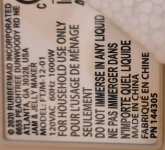EICS
Member
the age old question / issue
a friend has bought a 1000watt 120vac 60hz rated appliance from the USA into Australia (which has a 240Vac 50Hz supply).
other than using an invertor (240 1 phase input / 3 phase output) does anyone know of an off the shelf 240Vac 50Hz single phase input to 120Vac 60Hz single phase output rated at 6-8 amps specifically for this type of voltage/frequency matching ?
possibly some small UPS or similar.
a friend has bought a 1000watt 120vac 60hz rated appliance from the USA into Australia (which has a 240Vac 50Hz supply).
other than using an invertor (240 1 phase input / 3 phase output) does anyone know of an off the shelf 240Vac 50Hz single phase input to 120Vac 60Hz single phase output rated at 6-8 amps specifically for this type of voltage/frequency matching ?
possibly some small UPS or similar.







